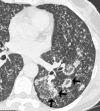The reversed halo sign: update and differential diagnosis
- PMID: 22553298
- PMCID: PMC3487053
- DOI: 10.1259/bjr/54532316
The reversed halo sign: update and differential diagnosis
Abstract
The reversed halo sign is characterised by a central ground-glass opacity surrounded by denser air-space consolidation in the shape of a crescent or a ring. It was first described on high-resolution CT as being specific for cryptogenic organising pneumonia. Since then, the reversed halo sign has been reported in association with a wide range of pulmonary diseases, including invasive pulmonary fungal infections, paracoccidioidomycosis, pneumocystis pneumonia, tuberculosis, community-acquired pneumonia, lymphomatoid granulomatosis, Wegener granulomatosis, lipoid pneumonia and sarcoidosis. It is also seen in pulmonary neoplasms and infarction, and following radiation therapy and radiofrequency ablation of pulmonary malignancies. In this article, we present the spectrum of neoplastic and non-neoplastic diseases that may show the reversed halo sign and offer helpful clues for assisting in the differential diagnosis. By integrating the patient's clinical history with the presence of the reversed halo sign and other accompanying radiological findings, the radiologist should be able to narrow the differential diagnosis substantially, and may be able to provide a presumptive final diagnosis, which may obviate the need for biopsy in selected cases, especially in the immunosuppressed population.
Figures













References
-
- Hansell DM, Bankier AA, MacMahon H, McLoud TC, Muller NL, Remy J. Fleischner Society: glossary of terms for thoracic imaging. Radiology 2008;246:697–722 - PubMed
-
- Zompatori M, Poletti V, Battista G, Diegoli M. Bronchiolitis obliterans with organizing pneumonia (BOOP), presenting as a ring-shaped opacity at HRCT (the atoll sign). A case report. Radiol Med 1999;97:308–10 - PubMed
-
- Voloudaki AE, Bouros DE, Froudarakis ME, Datseris GE, Apostolaki EG, Gourtsoyiannis NC. Crescentic and ring-shaped opacities. CT features in two cases of bronchiolitis obliterans organizing pneumonia (BOOP). Acta Radiol 1996;37:889–92 - PubMed
-
- Tzilas V, BA, Provata A, Koti A, Tzouda V, Tsoukalas G. The “reversed halo” sign in pneumonococcal pneumonia: a review with a case report. Eur Rev Med Pharmacol Sci 2010;14:481–86 - PubMed
-
- Marchiori E, Zanetti G, Escuissato DL, Souza AS, Jr, Meirelles GD, Fagundes J, et al. Reversed halo sign: high-resolution CT findings in 79 patients. Chest 2012;141:1260–6 - PubMed

